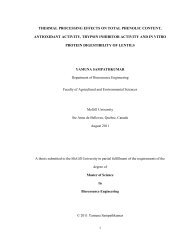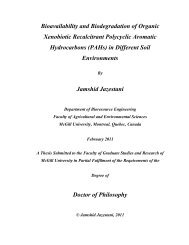Postharvest treatments to reduce chilling injury symptoms in stored ...
Postharvest treatments to reduce chilling injury symptoms in stored ...
Postharvest treatments to reduce chilling injury symptoms in stored ...
Create successful ePaper yourself
Turn your PDF publications into a flip-book with our unique Google optimized e-Paper software.
(QC, Canada) <strong>in</strong> refrigerated conta<strong>in</strong>ers ma<strong>in</strong>ta<strong>in</strong>ed at 10 ºC. They were received for the<br />
experiment on January 20, 2003. Fruits were approximately 17 days from harvest at the<br />
start of the experiment. Fruits of uniform size, shape and free of defects were used for the<br />
experiment. The average mass of an <strong>in</strong>dividual fruit was 650 g. Three lots of 5 mangoes<br />
were used <strong>to</strong> assess the quality of the mangoes on their arrival <strong>in</strong> the labora<strong>to</strong>ry.<br />
Prior <strong>to</strong> the start of the experiment, the mangoes were randomly divided <strong>in</strong><strong>to</strong> four<br />
lots of 60 mangoes. One of the four CI-<strong>treatments</strong> was then applied <strong>to</strong> each lot. The first<br />
lot did not receive any CI-treatment and was used as control. The second lots of 60<br />
mangoes were immersed <strong>in</strong> HW (50 + 2 ºC) for 10 m<strong>in</strong>. A vibrat<strong>in</strong>g water bath was used<br />
for this purpose. Mangoes from the third lot were exposed <strong>to</strong> MJ. A solution of 9:1 ratio<br />
of Ethanol and MJ was prepared and then diluted with water <strong>to</strong> get f<strong>in</strong>al concentration of<br />
10 -4 M. Mangoes were dipped <strong>in</strong> this solution for 2 m<strong>in</strong> and air dried. Mangoes from the<br />
fourth lot were dipped for 2.5-3.0 m<strong>in</strong> <strong>in</strong> a solution made of 12 mM DPA <strong>in</strong> 5 % ethanol<br />
and 0.05 % Tween 20, and air dried.<br />
After receiv<strong>in</strong>g their respective CI-treatment, each lot was then divided <strong>in</strong><strong>to</strong> four<br />
samples of 15 mangoes each and s<strong>to</strong>red <strong>in</strong> paper bags for 21 days at either 1, 4, 7 or 10<br />
ºC. At the end of s<strong>to</strong>rage, the quality of mangoes was assessed and compared.<br />
3.4.2 Quality assessment<br />
The parameters used <strong>to</strong> moni<strong>to</strong>r the quality of the mangoes before and after<br />
s<strong>to</strong>rage were: sk<strong>in</strong> and flesh color, pH, sugar content, texture, percentage of mass loss and<br />
percentage of good mangoes.<br />
Sk<strong>in</strong> and flesh colors were measured with a M<strong>in</strong>olta Chromameter Model CR-<br />
300X (M<strong>in</strong>olta camera Co. ltd., Japan) equipped with a 5 mm diameter measur<strong>in</strong>g area.<br />
Measurements were reported <strong>in</strong> terms of CIE (Commission Internationale de I’ Eclairage)<br />
L*a*b color space and expressed as L* (whiteness/darkness, ranged from 0 <strong>to</strong> 100, while<br />
100 be<strong>in</strong>g the lightest), a* (redness for positive value and greenness for the negative one)<br />
and b* (yellowness for positive and blueness for negative value) (McGuire, 1992).<br />
Calibration was performed aga<strong>in</strong>st a standardized white calibration plate accord<strong>in</strong>g <strong>to</strong> the<br />
manufacturer specifications.<br />
31









